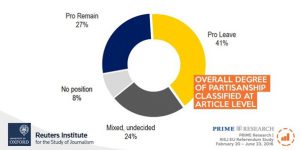PRIME Research UK and Oxford University’s Reuters Institute for the Study of Journalism teamed up to investigate what role the British press played in the EU referendum campaign. This research project led to a comprehensive report that was published last month. We talked to Richard Bagnall, CEO at PRIME Research UK Ltd and Diego Bironzo, Research Account Director at PRIME Research UK Ltd about the study, what surprised them most about the results, the measures that were applied in evaluating message delivery and finally asking them the Big Question: How much they believe the press coverage influenced people vote in the referendum?
Q: PRIME Research undertook together with the Reuters Institute for the Study of Journalism a study into press coverage of the EU referendum campaign. Can you please describe how PRIME Research contributed to this study?
RB & DB: This project started with PRIME Research and the RISJ discussing in detail the objectives of the study, and developing together a tailored coding structure that would allow us to answer all of the research questions which were felt to be pertinent.
The very first challenge we faced was the massive volumes of coverage about the referendum. In order to make the project manageable and to ensure the highest quality and depth of the data it was necessary to restrict the content for coding. The approach that was decided upon was to focus on the nine key British national newspapers for the four-month period of the referendum campaign (February to June). Additionally, the monitoring focused on two days’ press coverage each week – the Tuesday and Saturday editions of the papers.
Even with these restrictions in place, by referendum day on June 23, PRIME had sourced 3,403 relevant articles. The coding was conducted on a daily basis at a massively granular scale tailored to provide the best insights into the coverage. Coding was conducted art both the article level with the usual categories such as medium, date, headline, page number, position, prominence, size, section, image etc captured as well as very detailed ‘message’ level analysis too.
Once the data collection was over, the team at PRIME analysed the data looking for interesting patterns, which were then visualised for the RISJ’s team to interpret. This process was conducted in conjunction with PRIME Research’s account director, Diego Bironzo.
Q: What surprised you the most in the outcomes of the study?
RB & DB: As expected, several of the findings in the study didn’t come as a surprise to media watchers and those who followed the referendum debate in Britain. The study in many cases confirmed preconceptions about the political views of the UK’s media – for example the fact that on the whole the UK’s press coverage was skewed in favour of Brexit, or that the economy was the main topic discussed by the Remain camp. However, as Roy Greenslade pointed out in this Guardian piece reviewing the report’s findings, such rigorous research plays an essential role in confirming what otherwise would have been only an “impressionistic viewpoint.”
What was particularly fascinating was the comparison between PRIME’s media research data and YouGov’s exit poll broken down by newspaper readership. Although newspaper coverage was clearly skewed, in most cases it appeared to be in line with their readers’ opinion or votes. Only two newspapers, the Daily Mirror and The Times, didn’t align with their audience. The former’s readers were more inclined to vote Leave, regardless of the Mirror’s pro-Remain leaning, while the opposite was true for The Times.
Considering also all the financial pressure that news organisations are under, these data made us wonder whether newspapers tend to “follow” their audience, confirming their views, or try to set the agendas that may influence and change those views.
Q: What measures were applied in evaluating message delivery?
RB & DB: In addition to the article level coding, PRIME tracked message level analysis with multiple categories being coded independently at a top line and granular level. Broad areas of analysis included multiple top level categories including, but not limited to, language style used, tone, position / stance, EU deal attribute, and topic. Each top level category then had a multiple of variables coded within it. So, for example, under the broad category ‘language-style’ each of these sub-categories were also identified and coded: emotive, factual, data-driven, humorous and sarcastic. Likewise, under ‘topics’, each of the following were coded: ‘Sovereignty’, ‘Impact to Business / Economy’, ‘Migration / Mobility’, ‘Terrorism and Security’, ‘Regulations, Policies and Standards’ and ‘General – discussion re vote & other Brexit topics’. In this case, each topic category was further sub-divided into a myriad of sub-categories to provide the most granular analysis possible.
Q: How much do you believe the press coverage influenced people vote in the UK referendum?
RB & DB: Big question! As mentioned, at least at first glance, we found that the British press was particularly good at ‘preaching to the converted’, strengthening and supporting readers’ views rather than changing them. However, this campaign was particularly fascinating (and complex) also because it put into question the traditional party lines: the Conservative and to a lesser extent the Labour party were both split on the matter, with prominent figures backing opposite sides. This made it harder to develop linear narratives more typical of an election campaign. One key question that the report posed was to what extent did the press set the agenda for the broadcast news or vice-versa. A fascinating debate where this and other areas were covered was held at the launch of the report at an event held in the London offices of the European Parliament. This launch event was one of the AMEC measurement month events in September 2016. It featured a presentation of the report’s findings by Dr David Levy, the Director of the Reuters Institute for the Study of Journalism and fascinating insights form the CEO of Vote Leave, the Deputy Director of Britain Stronger In and other key players in the campaign. A short write up of the evening is available as well as a video of the night’s conversation here.
About Richard Bagnall and Diego Bironzo
Richard Bagnall, CEO PRIME Research UK Ltd @richardbagnall
Richard is a 20 year veteran of the PR and communications measurement industry. He was co-owner and MD of Metrica for 18 years, then led its sale to Gorkana where he remained as MD of global insights for 5 further years. In 2014 he joined global communications measurement specialists PRIME Research where he leads the company’s traditional and social media measurement consultancy practice throughout Europe. Richard is board director and the chair-elect of industry trade association AMEC where he recently led the launch of its integrated communication evaluation framework. As a member of the Cabinet Office Evaluation Council, Richard advises Government departments and Arm’s Length Bodies on effective communications measurement techniques. At the invitation of the Government Communications Service, Richard co-authored the UK Government’s digital communications review , the findings of which having been accepted are now being implemented.
Diego Bironzo, Account Director, PRIME Research UK Ltd @dbironzo
Diego is an Account Director at PRIME Research UK, where he heads the FinTech sector team and runs international communications measurement programmes on behalf of corporate clients and institutions. He has a Masters in Corporate Communication from the Universities of Turin and Lumière Lyon II. Diego has extensive experience in the fields of data mining and strategic analysis, with a particular focus on public affairs, monetary policymaking and the banking industry. Diego was the lead researcher at PRIME on the EU referendum analysis project.








